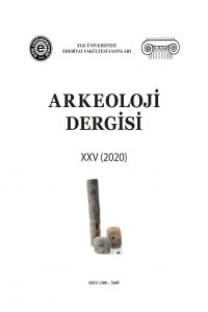TWO UNIQUE VOTIVE STELAE OF KAKASBOS/HERACLES/MASEIS FROM FETHİYE MUSEUM
TWO UNIQUE VOTIVE STELAE OF KAKASBOS/HERACLES/MASEIS FROM FETHİYE MUSEUM
Except the inscriptions, the identity of Kakasbos/Heracles/Maseis can be determined icono graphically as depicted on horse holding the pin in his right hand while the reins of his horse in his left hand, Kakasbos/Heracles/Maseis is mentioned as a God in most of the inscriptions. Even though both of the two votive stelae at Fethiye Museum have not any inscriptions, since there are pins in their hands; it is clear that they are votive stelae of Kakasbos/Heracles/Maseis. Votive stelae having descriptions of figures generally on horse mismatch iconigraphically with the votive stelae of Kakasbos/Heracles/Maseis which are examined in our study as one horse and one rider being headed from right to left. Although there are pins in their hands of votive stelae here, one of the rider is heading towards to left from right while another figure appears opposite of him. The rider of the second votive stela has also pin in his hand, but this time has been depicted frontally in front of his horse, as standing. With these features, both of the works have brought innovations to the iconography of Kakasbos/Heracles/Maseis which has been known in this way until now. These two unique votive stelae of Kakasbos/Heracles/Maseis were brought to Fethiye museum by purchasing. These works made of limestone are produced in a distinctive type during 2nd and 3rd century A.D. and evaluated as the products of a significant cult class, having local characteristics of north-northwest Lykia and Pisidia regions.
___
- Bean 1956: G.E. Bean, “Notes and Inscriptions from the Cibyratis and Caralitis”, BSA 51, 136-156.
- Bean 1971: G.E. Bean, Journeys in Northern Lycia 1965- 1967, Wien.
- CCET V: A. Cermanovic-Kuzmanovic, Corpus cultus equitis Thracii V. Etudes préliminaires aux religions orientales 74, Leiden, 1982.
- Corsten ve Hülden 2011: T. Corsten, O. Hülden, “Kibyratis Araştırmaları 2010/Research in the Kybiratis in 2010”, ANMED 9, 180-183.
- Delemen 1993: İ. Delemen, Anadolu’da Atlı Tanrılar. Lykia, Pisidia, Lykaonia, Isauria, Phrygia, Lydia ve Karia Bölgelerinde Taş Eserler Üzerine Bir İnceleme, İstanbul Üniversitesi SBE, (Yayınlanmamış Doktora Tezi), İstanbul.
- Delemen 1999: İ. Delemen, Anatolian Rider-Gods, AMS 35, Bonn.
- Delemen 2005: İ. Delemen, “Haluk Perk Müzesi’ndeki Thrak ve Anadolu Atlıları”, Tuliya 1, İstanbul, 149- 176.
- Dimitrova 2002: N. Dimitrova, “Inscriptions and Iconography in the Monuments of the Thracian Rider”, Hesperia 71, 209-229.
- Efendioğlu 2008: T. Efendioğlu, Hellenizm ve Roma Çağları Lykiası’nda Yerel Kültler, (Yayınlanmamış Yüksek Lisans Tezi), Marmara Üniversitesi SBE, İstanbul.
- Frei 1990: P. Frei, “Die Götterkulte Lykiens in der Kaiserzeit”, ANRW II.18.3, Berlin, 1729-1864.
- Gage 1926: J. Gage, “Deux dieux cavaliers d’Asie Mineure (d’après deux bas-reliefs inédits)”, MEFRA 43, 103-123.
- Horsley 1999: G.H.R. Horsley, The Rider God Steles at Burdur Museum in Turkey, Museum of Antiquities, Maurice Kelly Lectures 3, New England.
- Karayaka 2007: N. Karayaka, Hellenistik ve Roma Döneminde Pisidia Tanrıları, İstanbul.
- Kütük 1986: S. Kütük, “Kakasbos ve Kültü”, TTKong IX-I, 405-413.
- Linant de Bellefonds 1992: P. Linant de Bellefonds, “Kakasbos”, LIMC VI-1. Berlin, 1082-1084.
- Metzger 1952: H. Metzger, Catalogue des monuments votifs du Musée d’Adalia, Etudes Orientales, Paris.
- Naour 1980: Ch. Naour, Tyriaion en Cabalide: épigraphie et géographie historique, Zutphen.
- Özsait 2006: M. Özsait, “Burdur İli 2005 Yılı Yüzey Araştırmaları/Surveys in Burdur Province in 2005” ANMED 4, 93-98.
- Özsait 2008: M. Özsait, “Burdur, Isparta ve Antalya Yüzey Araştırmaları 2007/Surveys in the Provinces of Burdur, Isparta and Antalya in 2007”, ANMED 6, 105-111.
- Robert 1946: L. Robert, “Un dieu Anatolienne: Kakasbos”, Hellenica 3, 38-73, 173-174.
- Smith 2002: R.R.R. Smith (Çev. A.Y. Yıldırım), Hellenistik Heykel, İstanbul.
- Speidel 1993: M.P. Speidel, “Mauri equites. The tactics on light cavalry in Mauretania”, Antiquites Africaines 29, 121-126.
- Talooen ve Alp 2007: P. Talooen, N. Alp, “Pisidia Kültleri Antik Çağda Burdur İlinde Dinsel Hayat”, In: G. Yıldız, M.Z. Yıldırım, Ş. Kazan (Ed.), 1. Burdur Sempozyumu Bildiriler, 16-19 Kasım 2006, Burdur, 738-747.
- Robert 1946: L. Robert, “Un dieu Anatolienne: Kakasbos”, Hellenica 3, 38-73, 173-174.
- Smith 2002: R.R.R. Smith (Çev. A.Y. Yıldırım), Hellenistik Heykel, İstanbul.
- Speidel 1993: M.P. Speidel, “Mauri equites. The tactics on light cavalry in Mauretania”, Antiquites Africaines 29, 121-126.
- Talooen ve Alp 2007: P. Talooen, N. Alp, “Pisidia Kültleri Antik Çağda Burdur İlinde Dinsel Hayat”, In: G. Yıldız, M.Z. Yıldırım, Ş. Kazan (Ed.), 1. Burdur Sempozyumu Bildiriler, 16-19 Kasım 2006, Burdur, 738-747.
- ISSN: 1300-5685
- Yayın Aralığı: Yılda 2 Sayı
- Başlangıç: 1991
- Yayıncı: Ege Yayınları
Sayıdaki Diğer Makaleler
TWO UNIQUE VOTIVE STELAE OF KAKASBOS/HERACLES/MASEIS FROM FETHİYE MUSEUM
Güvercinkayası Damga Mühür ve Mühür Baskıları
Late Chalcolithic Pottery Assemblage from Başur Höyük
Emrullah KALKAN, Haluk SAĞLAMTİMUR
Isparta Müzesi'nden Bir Grup Bronz Heykelcik
Doğu Anadolu Bölgesi Geç Demir Çağı Ritonları
A Preliminary Study of Exchange and Bartering in the Villages of Aksaray
Pınar ÇAYLI, Işıl DEMİRTAŞ, Banu DOĞAN
Milas-TKİ Kazıları Işıkdere Oda Mezarı [MILAS-TKİ EXCAVATIONS: IŞIKDERE CHAMBER TOMB
Aytekin ERDOĞAN, Mehmet Nezih AYTAÇLAR
